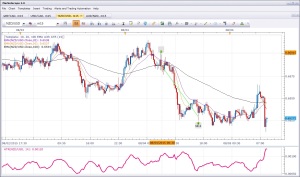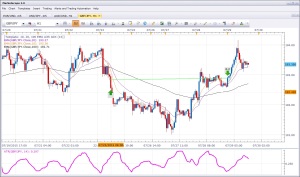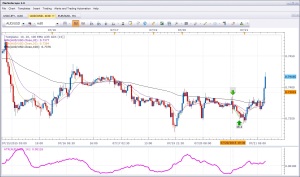The NZD is considered a weak currency right now, and this week Jarratt Davis suggested trading into some employment and labor figures from New Zealand. I took a short position about 15 minutes after the Global Dairy Trade price index data release, and held through until the employment figures at 4:45pm my local time. The trade was helped along through the afternoon by some bullish comments from US Bank of Atlanta President Dennis Lockhart.
There were actually (2) lots on this trade, but the first cleared out before I could get a screenshot. At 8:15am my local time, the Global Dairy Trade price index fell by 9.3%, and milk powder price index fell by 10.3%. This data does not support New Zealand exports and growth, and so I entered my short position. Bullish sentiment on the USD pushed the NZDUSD pair lower through the day, and I took profit of about 30 pips on my first lot. The employment data was a slight miss at 4:45pm, and right after the data release I took profit on my second lot for about 60 pips, which was about 60% of the 100 pip daily range.
Market Sentiment
- Dropping prices in the GDT index
- Employment figures that are weaker than or in-line with expectations could build selling pressure in NZD
Market Fundamentals
- RBNZ cut Interest Rates to 3.25% on June 11, and cut to 3% on July 23
- More interest rate cuts from RBNZ are expected in September
- Further weakness against USD is expected
- US Federal Reserve planning to raise interest rates in September or December 2015
Trading Plan: position for NZD weakness after GDT price index data, and heading into New Zealand employment data. Trading against USD which is the fundamentally strongest currency long-term.
Result: The weak data from New Zealand helped build selling pressure in the NZD, and Market Sentiment really pushed up the USD. Atlanta Fed president Lockhart is known more for a dovish stance, and his bullish comments about a September interest rate hike as being “appropriate” really invigorated USD.
Comments: The favorable Sentiment for USD was unexpected, but I was on the fundamentally correct side of the currency pair to enjoy the surprise. The Double Lot worked well in this trade, to lock in some initial profits and then let the second lot cook. In subsequent trades, I’ll consider using a trailing stop on the second lot, and let it run indefinitely, or hit the stop. For this trade, I’m satisfied with getting 30 pips on one lot and 60 pips on the other when the daily range is about 100 pips. No reason to be greedy right now.





